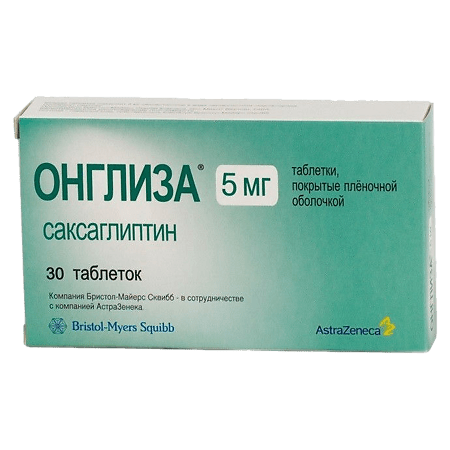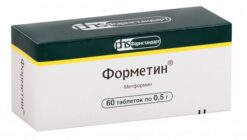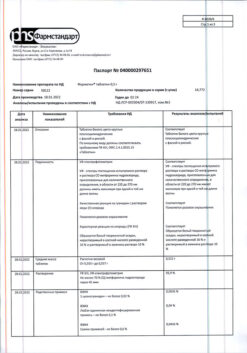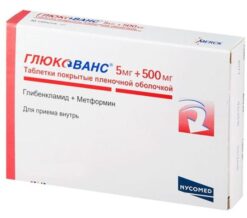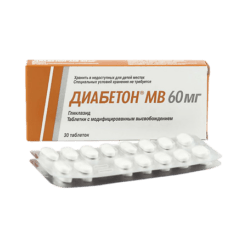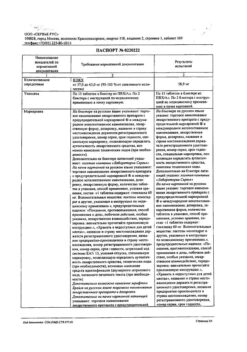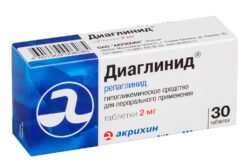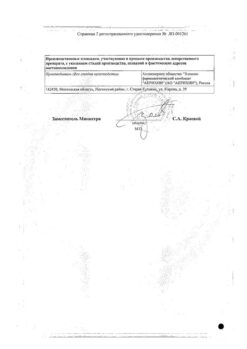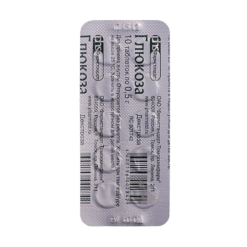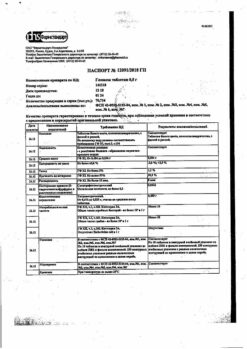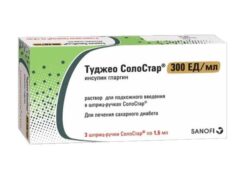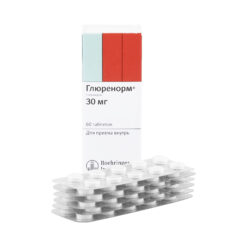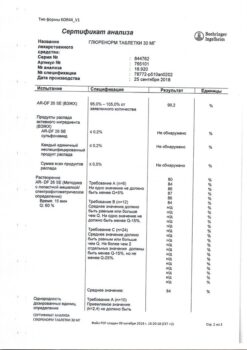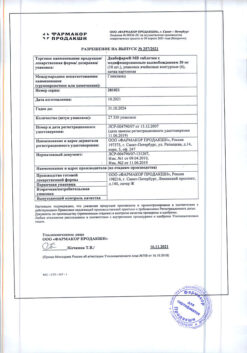No products in the cart.
Onglyza, 5 mg 30 pcs.
€51.90 €44.98
Description
Onglyza has hypoglycemic action.
Pharmacodynamics
Saxagliptin is a potent selective reversible competitive inhibitor of dipeptidyl peptidase-4 (DPP-4). In patients with type 2 diabetes mellitus (DM2) administration of saxagliptin leads to suppression of DPP-4 enzyme activity within 24 hours. After glucose ingestion, inhibition of DPP-4 leads to 2-3 times increased concentration of glucagon-like peptide-1 (GFP-1) and glucose-dependent insulinotropic polypeptide (GIP), decreased concentration of glucagon and increased glucose-dependent response of beta-cells, which leads to increased concentration of insulin and C-peptide. Insulin release by pancreatic beta-cells and decrease of glucagon release from pancreatic alpha-cells leads to decrease of fasting and postprandial glycemia.
The efficacy and safety of saxagliptin at doses of 2.5 mg, 5 mg, and 10 mg once daily have been studied in six double-blind, placebo-controlled studies involving 4148 patients with DM2. Administration of the drug was accompanied by statistically significant improvement of glycosylated hemoglobin (HbAlc), fasting plasma glucose (FPG) and postprandial plasma glucose (PPG) compared to controls.
Patients in whom the target glycemic level could not be achieved when receiving saxagliptin as monotherapy were additionally prescribed metformin, glibenclamide or thiazolidinediones. When receiving saxagliptin in a dose of 5 mg, a decrease in HbAlc was observed after 4 weeks and in HbAlc after 2 weeks.
In the group of patients receiving saxagliptin in combination with metformin, glibenclamide, or thiazolidinedione, a decrease in HbAlc was also noted after 4 weeks and HbA at 2 weeks.
The effect of saxagliptin on lipid profile is similar to that of placebo. No increase in body weight was noted during saxagliptin therapy.
Pharmacokinetics
The pharmacokinetics parameters of saxagliptin and its main metabolite are similar in patients with DM2 and healthy volunteers. Saxagliptin is rapidly absorbed after oral administration on an empty stomach with reaching the maximum concentration of saxagliptin and the main metabolite in plasma (Cmax) within 2 h and 4 h, respectively. When the dose of saxagliptin was increased, there was a proportional increase in Cmax and the area under the curve “concentration-time” (AUC) of saxagliptin and its main metabolite. After a single oral dose of 5 mg of saxagliptin in healthy volunteers, the mean AUC values of saxagliptin and its major metabolite were 78 ng/h/mL and 214 ng/h/mL, and plasma Cmax values were 24 ng/mL and 47 ng/mL, respectively.
The mean duration of the final half-life (t½) of saxagliptin and its major metabolite was 2.5 h and 3.1 h, respectively, and the mean t½ plasma inhibition of DPP-4 was 26.9 h. Inhibition of plasma DPP-4 activity for at least 24 h after administration of saxagliptin is due to its high affinity for and prolonged binding to DPP-4. No appreciable cumulation of saxagliptin and its major metabolite was observed with long-term administration of the drug once daily. No dependence of clearance of saxagliptin and its main metabolite was revealed depending on the dose of preparation and duration of therapy when saxagliptin was taken once daily in doses from 2.5 mg to 400 mg for 14 days.
Absorption
At least 75% of the administered dose of saxagliptin is absorbed after oral administration. Food intake had no significant effect on the pharmacokinetics of saxagliptin in healthy volunteers. High-fat meal had no effect on saxagliptin Cmax, whereas AUC was increased by 27% compared to fasting meal. The time to reach Cmax (Tmax) for saxagliptin was increased by approximately 0.5 h when the drug was taken with food compared with fasting food intake. However, these changes are not clinically significant.
Distribution
The binding of saxagliptin and its major metabolite to serum proteins is insignificant, so it can be assumed that the distribution of saxagliptin in changes in serum proteins noted in hepatic or renal failure will not be subject to significant changes.
Metabolism
Saxagliptin is metabolized mainly with the participation of cytochrome P450 isoenzymes ZA4/5 (CYP3A4/5) to form the active main metabolite, whose inhibitory effect against DPP-4 is 2 times weaker than that of saxagliptin.
Elimation
Saxagliptin is excreted with urine and bile. After a single dose of 50 mg of 14C-labeled saxagliptin, 24% of the dose was excreted by the kidneys as unchanged saxagliptin and 36% as the major metabolite saxagliptin. Total radioactivity detected in the urine corresponded to 75% of the dose taken. Mean renal clearance of saxagliptin was approximately 230 ml/min, and mean glomerular filtration was approximately 120 ml/min.
For the main metabolite, renal clearance was comparable to the mean glomerular filtration values.
About 22% of the total radioactivity was detected in the feces.
Indications
Indications
Type 2 diabetes in addition to diet and exercise to improve glycemic control as:
monotherapy;
initial combination therapy with metformin;
addition to monotherapy with metformin, thiazolidinediones, sulfonylurea derivatives, in the absence of adequate glycemic control on this therapy.
Pharmacological effect
Pharmacological effect
Ongliza has a hypoglycemic effect.
Pharmacodynamics
Saxagliptin is a potent selective reversible competitive inhibitor of dipeptidyl peptidase-4 (DPP-4). In patients with type 2 diabetes mellitus (T2DM), taking saxagliptin leads to suppression of the activity of the DPP-4 enzyme for 24 hours. After oral glucose administration, inhibition of DPP-4 leads to a 2-3 fold increase in the concentration of glucagon-like peptide-1 (GLP-1) and glucose-dependent insulinotropic polypeptide (GIP), a decrease in the concentration of glucagon and an increase in glucose-dependent response of beta cells, which leads to increased concentrations of insulin and C-peptide. Release of insulin from pancreatic beta cells and decreased release of glucagon from pancreatic alpha cells results in decreased fasting and postprandial glycemia.
The efficacy and safety of saxagliptin at doses of 2.5 mg, 5 mg and 10 mg once daily were studied in six double-blind, placebo-controlled studies involving 4148 patients with T2DM. Taking the drug was accompanied by a statistically significant improvement in glycosylated hemoglobin (HbAlc), fasting plasma glucose (FPG) and postprandial plasma glucose (PPG) compared to the control.
Patients in whom the target glycemic level could not be achieved while taking saxagliptin as monotherapy were additionally prescribed metformin, glibenclamide or thiazolidinediones. When taking saxagliptin at a dose of 5 mg, a decrease in HbAlc was noted after 4 weeks and FPG after 2 weeks.
In the group of patients receiving saxagliptin in combination with metformin, glibenclamide or thiazolidinediones, a decrease in HbAlc was also observed after 4 weeks and FPG after 2 weeks.
The effect of saxagliptin on the lipid profile was similar to that of placebo. No weight gain was observed during saxagliptin therapy.
Pharmacokinetics
In patients with T2DM and healthy volunteers, similar parameters of the pharmacokinetics of saxagliptin and its main metabolite were observed. Saxagliptin is rapidly absorbed after oral administration on an empty stomach, with maximum plasma concentrations of saxagliptin and the major metabolite (Cmax) achieved within 2 hours and 4 hours, respectively. With an increase in the dose of saxagliptin, a proportional increase in Cmax and the area under the concentration-time curve (AUC) of saxagliptin and its main metabolite was noted. Following a single 5 mg oral dose of saxagliptin to healthy volunteers, the mean AUC values of saxagliptin and its major metabolite were 78 ngch/ml and 214 ngh/ml, and plasma Cmax values were 24 ng/ml and 47 ng/ml, respectively.
The mean terminal half-life (t½) of saxagliptin and its major metabolite was 2.5 hours and 3.1 hours, respectively, and the mean t½ of plasma DPP-4 inhibition was 26.9 hours. Inhibition of plasma DPP-4 activity for at least 24 hours after administration of saxagliptin is due to its high affinity for and prolonged binding to DPP-4. No noticeable accumulation of saxagliptin and its main metabolite was observed during long-term administration of the drug once a day. There was no dependence of the clearance of saxagliptin and its main metabolite on the drug dose and duration of therapy when taking saxagliptin once a day in doses from 2.5 mg to 400 mg for 14 days.
Suction
After oral administration, at least 75% of the administered dose of saxagliptin is absorbed. Food intake did not have a significant effect on the pharmacokinetics of saxagliptin in healthy volunteers. A high-fat meal had no effect on saxagliptin Cmax, whereas AUC increased by 27% compared to fasting. The time to reach Cmax (Tmax) for saxagliptin increased by approximately 0.5 hours when taking the drug with food compared to taking it on an empty stomach. However, these changes are not clinically significant.
Distribution
The binding of saxagliptin and its main metabolite to serum proteins is insignificant, so it can be assumed that the distribution of saxagliptin will not be subject to significant changes due to changes in the protein composition of the blood serum, observed in liver or renal failure.
Metabolism
Saxagliptin is metabolized mainly with the participation of cytochrome P450 3A4/5 isoenzymes (CYP3A4/5) with the formation of an active main metabolite, the inhibitory effect of which on DPP-4 is 2 times less pronounced than that of saxagliptin.
Removal
Saxagliptin is excreted in urine and bile. After a single dose of 50 mg of 14C-labeled saxagliptin, 24% of the dose was excreted by the kidneys as unchanged saxagliptin and 36% as the main metabolite of saxagliptin. The total radioactivity detected in the urine corresponded to 75% of the dose taken. The mean renal clearance of saxagliptin was approximately 230 ml/min, and the mean glomerular filtration rate was approximately 120 ml/min.
For the main metabolite, renal clearance was comparable to mean glomerular filtration values.
About 22% of the total radioactivity was found in feces.
Special instructions
Special instructions
The use of Ongliza® in combination with insulin, as well as as part of triple therapy with metformin and thiazolidinediones or metformin and sulfonylurea derivatives, has not been studied.
Patients with impaired renal function.
Dose adjustment is recommended for patients with moderate to severe renal impairment, as well as for patients on hemodialysis. Before starting therapy and periodically during treatment with the drug, it is recommended to evaluate renal function.
Use in combination with drugs that can cause hypoglycemia.
Sulfonylureas may cause hypoglycemia; therefore, a reduction in the dose of sulfonylureas may be necessary to reduce the risk of hypoglycemia when used concomitantly with Onglyza.
Hypersensitivity reactions.
The drug should not be prescribed to patients who have experienced serious hypersensitivity reactions when using other DPP-4 inhibitors.
Elderly patients.
According to clinical studies, efficacy and safety rates in patients aged 65 years and older did not differ from those in younger patients. However, increased individual sensitivity to saxagliptin in some elderly patients cannot be excluded.
Saxagliptin and its main metabolite are partially eliminated by the kidneys, so it must be taken into account that elderly patients are more likely to have decreased renal function. Ongliza® contains lactose. Patients with congenital galactose intolerance, lactase deficiency and glucose-galactose malabsorption should not take this drug.
Influence on the ability to drive vehicles and operate machinery.
No studies have been conducted to study the effect of saxagliptin on the ability to drive vehicles and operate machinery. Please note that saxagliptin may cause dizziness.
Active ingredient
Active ingredient
Saxagliptin
Composition
Composition
Active ingredient:
saxagliptin in the form of saxagliptin hydrochloride;
Excipients:
lactose monohydrate,
microcrystalline cellulose,
croscarmellose sodium,
magnesium stearate,
1 M hydrochloric acid solution or 1 M sodium hydroxide solution,
Opadry II white [polyvinyl alcohol, titanium dioxide, macrogol (PEG 3350), talc],
Opadry II yellow [polyvinyl alcohol, titanium dioxide, macrogol (PEG 3350),
talc, yellow iron oxide dye (E172)] (for a dosage of 2.5 mg),
Opadry II pink [polyvinyl alcohol, titanium dioxide, macrogol (PEG 3350), talc, red iron oxide dye (E172)] (for a dosage of 5.0 mg), Opacode blue ink
Pregnancy
Pregnancy
Due to the fact that the use of saxagliptin during pregnancy has not been studied, the drug should not be prescribed during this period.
It is not known whether saxagliptin passes into breast milk.
Due to the fact that the possibility of saxagliptin passing into breast milk cannot be excluded, breastfeeding should be stopped during treatment with saxagliptin or therapy should be discontinued, taking into account the balance of risk for the child and benefit for the mother.
Contraindications
Contraindications
Increased individual sensitivity to any component of the drug;
Diabetes mellitus type 1 (use not studied);
Use together with insulin (not studied);
Diabetic ketoacidosis;
Congenital galactose intolerance, lactase deficiency and glucose-galactose malabsorption;
Pregnancy, lactation;
Age up to 18 years (safety and effectiveness have not been studied).
With caution: moderate to severe renal failure; elderly patients; combined use with sulfonylurea derivatives.
Interaction
Interaction
Analysis of clinical trial data suggests that the risk of clinically significant interactions between saxagliptin and other drugs when used together is low.
The metabolism of saxagliptin is predominantly mediated by the cytochrome P450 3A4/5 isoenzyme system (CYP3A4/5). In vitro studies have shown that saxagliptin and its main metabolite do not inhibit CYP isoenzymes 1A2, 2A6, 2B6, 2C9, 2C19, 2D6, 2E1 and 3A4 and do not induce CYP isoenzymes 1A2, 2B6, 2C9, and 3A4. In studies involving healthy volunteers, the pharmacokinetic parameters of saxagliptin and its main metabolite were not significantly changed by metformin, glibenclamide, pioglitazone, digoxin, simvastatin, diltiazem, ketoconazole, omeprazole, a combination of aluminum hydroxide, magnesium hydroxide and simethicone, as well as famotidine. Saxagliptin does not significantly change the pharmacokinetic parameters of metformin, glibenclamide, pioglitazone, digoxin, simvastatin, diltiazem or ketoconazole.
The effect of inducers of CYP 3A4/5 isoenzymes on the pharmacokinetics of saxagliptin has not been studied. However, the combined use of saxagliptin and inducers of CYP 3A4/5 isoenzymes, such as carbamazepine, dexamethasone, phenobarbital, phenytoin and rifampicin, may lead to a decrease in the concentration of saxagliptin in plasma and an increase in the concentration of its main metabolite. The effects of smoking, dietary intake, herbal preparations and alcohol consumption on saxagliptin therapy have not been studied.
Overdose
Overdose
Symptoms of intoxication are not described with long-term use of the drug in doses up to 80 times higher than recommended.
Treatment:
in case of overdose, symptomatic therapy should be used. Saxagliptin and its main metabolite are eliminated from the body by hemodialysis (removal rate: 23% of the dose in 4 hours).
Storage conditions
Storage conditions
At a temperature not exceeding 30 °C.
Shelf life
Shelf life
2 years
Manufacturer
Manufacturer
AstraZeneca Pharmaceuticals LP, USA
Additional information
| Shelf life | 2 years |
|---|---|
| Conditions of storage | At a temperature not exceeding 30 °C. |
| Manufacturer | AstraZeneca Pharmaceuticals LP, USA |
| Medication form | pills |
| Brand | AstraZeneca Pharmaceuticals LP |
Related products
Buy Onglyza, 5 mg 30 pcs. with delivery to USA, UK, Europe and over 120 other countries.

